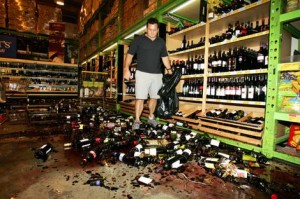Earthquake in New Zealand has killed 65 people
More than 100 people are believed to be trapped in rubble after a deadly 6,3-magnitude earthquake rocked the southern New Zealand city of Christchurch on Tuesday.
Christchurch Mayor Bob Parker declared a state of emergency and ordered people to evacuate the city centre following the quake, which has killed at least 65 people. Parker said rescue teams including sniffer dogs were fanning out.
“The government is willing to throw everything it can in the rescue effort” – Deputy Prime Minister Bill English said. “Time is going to be of essence.
“I rang my kids to say goodbye” – said Ann Voss, interviewed by TV3 from underneath her desk, where she was trapped in a collapsed office building. “It was absolutely horrible. My daughter was crying and I was crying because I honestly thought that was it. You know, you want to tell them you love them, don’t you?”
She said she could hear other people still alive in the building, and had called out to them and communicated by knocking on rubble.
“I’m not going to give up” – she said. “I’m going to stay awake now. They better come and get me.”

- New Zealand earthquake.
The New Zealand Red Cross has activated their national emergency operations centre (NEOC) in response to the 6,3-magnitude earthquake. The New Zealand Red Cross responded immediately after the earthquake hit, providing first aid assistance and distributing blankets.
Eight emergency response teams have been deployed to the affected region. Two teams are already on the ground in Christchurch, and additional teams from Nelson and Blenheim local Red Cross braches are on their way. 1800 blankets, 2000 water containers and 200 tents have been dispatched from the Auckland warehouse to assist the response.
New Zealand Red Cross staff and volunteers will be working around the clock to support people affected by this earthquake. Local volunteers reacted immediately, providing first aid support to help the emergency services. And additional emergency staff and supplies will be in the area by tomorrow morning.
The national emergency operations centre will be co-ordinating the Red Cross response, and is operational 24 hours a day. The Red Cross is working with the civil defence, New Zealand police, and local councils and agencies to assess the needs and determine how the Red Cross can best assist. One evacuation centre has been opened for around 2.000 people and more temporary accommodation is likely to be needed.
The following is a list of New Zealand’s biggest and most destructive quakes since 1848:
1 – October 16, 1848. A 7.8 magnitude earthquake hit Marlborough, at the top of the South Island, killing three people.
2 – January 13, 1855. An earthquake measuring 8.2 on the open-ended Richter scale hit Wellington, lifting land levels by up to three metres and killing four settlers and an unspecified number of indigenous Maori.
3 – June 17, 1929. A 7.8 quake struck in the top of the South Island, killing 17 people.
4 – February 3, 1931. A 7.8 quake hit Napier, Hawke’s Bay, killing 256 people, the country’s deadliest natural disaster. It also caused extensive damage.
5 – March 5, 1934. A 7.6 magnitude quake struck in the lower North Island and was felt as far away as Auckland in the north and Dunedin in the South Island. The quake caused widespread damage, but no one was killed.
6 – June 24, 1942. An earthquake measuring 7.2 hit Wairarapa, killing one person but causing extensive damage.
7 – August 2, 1942. Wairarapa, in the lower North Island, was struck with a 7.0 magnitude quake, just five weeks after it had been hit with a slightly stronger tremor.
8 – May 24, 1968. A 7.1 magnitude quake hit a sparsely populated area around the town of Inangahua in the South Island, killing three people and caused widespread destruction. It was felt over much of the country.
9 – March 2, 1987. A 6.8 magnitude quake struck the Bay of Plenty region on the east coast of the North Island. The shallow quake caused widespread damage to small towns but there were no casualties.
10 – December 20, 2007. A 6.8 magnitude quake hit the North Island city of Gisborne. It caused no casualties.
11 – July 16, 2009. A 7.8 earthquake struck the remote southwest Fiordland region of New Zealand’s South Island, causing a small tsunami. It caused only slight damage to buildings.
12 – September 4, 2010. A 7.1 magnitude shake struck Christchurch, causing an estimated NZ$4 billion in damage, making it the most destructive quake since 1931. There were no deaths and only two serious injuries.
13 – February 22, 2011. A 6.3 magnitude earthquake hit Christchurch, killing at least 65 people and caused widespread damage because it was shallow and close to the city centre.